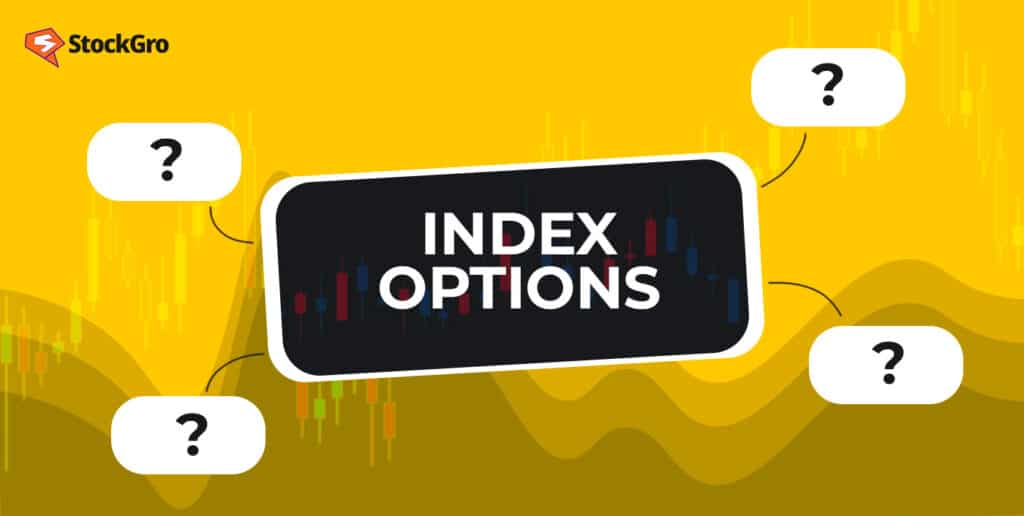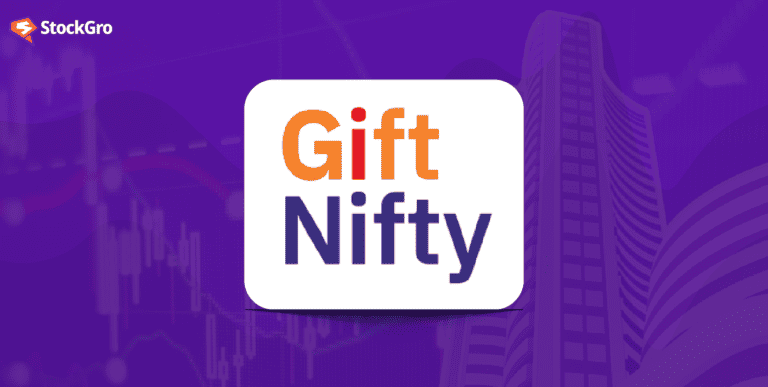
Index options in India were first introduced in 2001 on the NSE and since then they have come a long way. The trading statistics for FY 22-23 indicate that index options trading is immensely popular in India, with the National Stock Exchange of India (NSE) recording an impressive average daily turnover of over ₹94,55,000 crore in index options trading.
Index options are derivative trading instruments which trade on the same recognised stock exchange as the underlying. Similarly, stock options have a particular stock as the base.
Index options are related to a well-accepted index such as the Nifty, Sensex, Bank Nifty, etc. The value of an index option is derived from the movement of its underlying index.
Index options are available for indices whose futures are already on the market. This provides a benchmark for index option pricing. Establishing lot sizes, strike prices, and expiration dates makes trading of index options viable. Different index options have different lot sizes, multiple strike prices and different expiry periods.
The expiry date of options is either weekly or monthly. The weekly expiry is on every Thursday, while the monthly expiry is on the last Thursday of the month. Let’s understand in detail what are index options, how they work and their types.
You may also like: What is Short-Selling, and how does it work?
How does index options work?
Trading on stock index options involves buying or selling the options contracts of an underlying stock market index. Nifty and Bank Nifty options are the most commonly traded index options in India.
The NSE lists the 50 most liquid and large-cap stocks, which make up the widely followed Nifty 50 index. Bank nifty, as its name suggests, includes banking stocks.
When a person trades in an index option, it gives him the right, but not the obligation, to trade in the underlying index. At a predetermined price (strike price), on or before its expiry date. Index options allow traders to speculate on the trends of an entire market segment without trading in the options of individual securities.
Using index options, you can trade in an underlying stock index for a defined period. They also allow you to diversify your trading portfolio as they are based on a large basket of stocks in the underlying index.
So instead of trading in specific business shares, traders can use index options to get hedging exposure to all the stocks or the entire sector segment included in an index.
For example, trading in Bank Nifty options gives the trader a hedging exposure to all banking stocks included in Bank Nifty.
Types of index options
The two most basic types of index options are Call Options and Put Options.
Index options are named after their underlying index. For example, all call options and put options traded on the Nifty50 are called Nifty50 Index Options or just Nifty50 Options. Options can also be classified as:
- In the money
- At the money
- Out of the money
Index options are “in the money” when the index price is above the strike price at expiration. When the index price is the same as the strike price, it is an “at the money option”. And when the index price is below the strike price, it is an “out of the money” option.
Also Read: Dividend Rate vs. Dividend Yield
Call options
Call options are agreements which allow the buyer the right to buy a specified quantity of an underlying index at a pre-decided price. The buyer of the call option pays an upfront premium to the seller or the option writer for this privilege.
Index call option investors want the index to exceed the strike price before the option expires. This will enable them to exercise their right to buy the index at the lower strike price and sell it at the higher market price, leading to a profit.
The call option buyer makes a profit when the price of the underlying index increases as it raises the price of the option too.
For example, a person buys a Nifty call option with a strike price of 18700 with an expiry date of 15th June 2023, @10, when the current traded value of Nifty is 18680.
When Nifty value goes up, call option price increases. A 100-point rise can result in a profit if the call is sold at the right time.
The lot size of a Nifty call option is 50, and if the trader has bought 5 calls, the profit calculation will be:
(25-10)*250 (5 lots of 50)= 3750 (before brokerage and other charges)
An index option buyer has to exercise his/her option before the expiry date of that option. For instance, in the example given above the expiry date of the call option is 15th June.
Hence the call buyer must exercise the option on or before this date. It is important to note that as the expiry date of the index option comes closer, the value of the options starts to decline, irrespective of the value of the underlying index.
Also Read: Difference between Nifty and Sensex
Put options
In a put option the buyer gets the right to sell a specified quantity of an underlying index at a pre-decided price and for this privilege pays an upfront premium to the put option seller or writer.
When a trader buys a put index option, he is speculating that the index price will see a downturn. For instance, if Nifty is at 18700 and the trader expects this value to go down to 18500, a good trading strategy would be to buy a put option with a strike price of 18500.
So, an index call option gives the option holder the right to buy the underlying index at the strike price, while a put option gives the right to sell the underlying index at the strike price.
Traders commonly use index options to hedge their portfolios or speculate on the direction the index is going to take. Since the value of an index option moves according to the overall performance of its underlying index and not the performance of an individual stock, it helps in minimising the risk.
Final thoughts
Index options have become a popular trading option in India as they provide a safe avenue to traders for hedging their risks and making profits. However, they also come with certain risks that traders must understand fully before getting started.
This would help them trade effectively in index options by minimising their risks. As the Indian financial markets are growing at a fast pace, index options trading is gaining popularity and seeing higher turnovers.



Leave a Comment